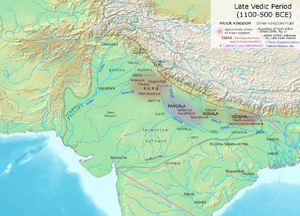Assandh


Assandh (असंध) is village and Tehsil situated in Karnal District of Haryana.
Variants
- Asand
- Asandh
- Asandi/Āsandi (आसन्दी)=Makandi (माकन्दी) Mahabharata (V.31.19)
- Asandivat
- Asandivata
- Ahisthala (अहिस्थल) = Asandivata (आसंदीवत) (AS, p.57)
- Asandivata (आसंदीवत) (AS, p.72)
- Asandivat (आसन्दीवत्) = Hastinapura हस्तिनापुर (AS, p.1016)
Mention by Panini
Asandi (आसन्दी) is name of a place mentioned by Panini in Ashtadhyayi under Madhvadi (मध्वादि) (4.2.86) group. [1]
Asandi (आसंदी) is a term mentioned by Panini in Ashtadhyayi. [2]
Asandivat (आसंदीवत) is a term mentioned by Panini in Ashtadhyayi. [3]
V S Agarwal[4] mentions.... Asandivat (आसंदीवत) (VIII,2.12; IV.2.86), name of the royal city of Janamejaya Parikshita, in which the horse for his famous sacrifice was bound (Vedic Index, I,72); the Kasika equates it with Ahisthala (अहिस्थल).
Jat Gotras
Villages in Assandh tahsil
Alawla, Ardana, Assandh (MC), Bahri, Balla, Balona, Bassi, Bhambar Heri, Bindrala, Bir Bassi, Chaugawan, Chochran, Danauli, Dopedi, Gangatheri, Goli, Ichhanpur, Jai Singhpura, Jalmana, Jhabala, Jhimri Khera, Kaboolpur, Karsa Chaur, Kaul, Khaktor, Khanda Kheri, Kheri Sharafali, Khizarabad, Kurlan, Lalain Panghala, Mardan Heri, Mor Majra, Mundh, Pacca Khera, Padha, Phaphrana, Popra, Rahra, Rattak, Risalwa, Ruksana, Salwan, Sheikhupura Manchuri, Thal, Thari, Tharwa Majra, Uplana, Uplani,
History
Asandh in Karnal has a remarkable history and is one of the tallest Buddhist Stupas in North India which is 2,000 years old.
According to Bhim Singh Dahiya[5], the Dahiyas have already been described. However, here we want to draw attention to the mention of their country and some of their princes. Asandivat is mentioned as the capital of Janmejaya in Ramayana and Panini. Commenting on Panini, Kāsikā mentions Āsandi along with Dahisthalam. Har Datta, the author of Padamanjarikara mentions Asandi and Dahisthalam as names of particular countries or areas.[6]
- आसंदी व् दहिस्थलम् देशविशेष: यत्रेदमुच्यते
Inscriptional evidence mentions Dahisthala on the bank of Saraswati river where Kshemarāja Chālukya of Anhilvāḍa did penance. [7]
From the above discussion it is clear that the places mentioned is somewhere in the Haryana area. Now there is an important town near Panipat which is called Asandh even today and the area of Dahiya clan is not far from this place. It is therefore clear that the ancient Asandi or Asandivat is the present Asand town and Dahisthal is the country of the Dahiya clan. Kinsariya inscriptions of Chachha Dahiya of 1056-57 SV. are reported in El, Vol. XII, pp. 56-57. He is mentioned as "Kulam Dahiyākam Jātam" and the inscriptions gives at least four generations of that prince. Another inscription of Chandrāvati Sitaleshvara Mahadeva temple mentions a Rauta Bhivasiha Dahiya and his son Rauta Uda Dahiya (Sl. No. 1856 of Inscriptions of North India).
आसंदीवत
विजयेन्द्र कुमार माथुर[8] ने लेख किया है ...आसंदीवत (AS, p.72): पांडवों के वंशज तथा परीक्षित के पुत्र जनमेजय की राजधानी थी। ऐतरेय ब्राह्मण की एक गाथा 8,21 में इसका उल्लेख इस प्रकार है- 'आसंदीवतिधान्यादं रुकमणं हरितंत्रजम्। अश्वं बबंधसारंग देवभ्यो जनमेजय इति'।
अर्थात देवों के लिए यज्ञार्थ जनमेजय ने आसन्दीवत् में एक स्वर्ण अलंकृत पीली माला धारण किए हुए श्याम रंग का अश्व बांधा। परीक्षित की राजधानी हस्तिनापुर में थी और इसी से जान पड़ता है कि आसंदीवत् हस्तिनापुर का ही दूसरा नाम था। किंतु यह अभिज्ञान पूर्णतः निश्चित नहीं कहा जा सकता क्योंकि महाभारत 13,5,34 में जनमेजय की राज्यसभा को तक्षशिला में बताया गया है। पाणिनी ने अष्टाध्यायी 4,2,12 और 4,2,86 में इसके नाम का उल्लेख किया है। काशिका 24,226 के अनुसार (कुरुक्षेत्रे परिणाहि स्थले) यह कुरुक्षेत्र के परिवर्ती प्रदेश का अभिधान था। इसे अहिस्थल भी कहते थे।
पाणिनि कालीन भारतवर्ष का एक स्थान था। यह जनमेजय परीक्षित की राजधानी का नाम था, इसी में उन्होंने अश्वमेध यज्ञ किया था। (वैदिक इंडेक्स 1।72) काशिका के अनुसार यह अहिस्थल था, जो कुरुक्षेत्र के पास था।[9][10]
In Mahabharata
Udyoga Parva/Mahabharata Book V Chapter 31 mentions that Pandavas were desirous of peace and demanded only five villages: Kushasthala, Vrikasthala, Asandi, Varanavata, and for the fifth any other village to end the quarrel. [11]
Notable person
External Links
References
- ↑ V. S. Agrawala: India as Known to Panini, 1953, p.505
- ↑ V. S. Agrawala: India as Known to Panini, 1953, p.144
- ↑ V. S. Agrawala: India as Known to Panini, 1953, p.54, 71, 144
- ↑ V S Agarwal: India as Known to Panini, p.71, sn.25.
- ↑ Jats the Ancient Rulers (A clan study), Book by Bhim Singh Dahiya, IRS, First Edition 1980, Publisher: Sterling Publishers Pvt Ltd, AB/9 Safdarjang Enclave, New Delhi-110064, p.336
- ↑ G.C. Awasthi, Veda Dhratala, p, 58,
- ↑ RC. Ray, op. cit. ,p. 953,
- ↑ Aitihasik Sthanavali by Vijayendra Kumar Mathur, p.72
- ↑ कुरुक्षेत्रे परेणाहिस्थले, कात्या. श्रौ. 24।226
- ↑ पाणिनीकालीन भारत |लेखक: वासुदेवशरण अग्रवाल |प्रकाशक: चौखम्बा विद्याभवन, वाराणसी-1 |संकलन: भारतकोश पुस्तकालय |पृष्ठ संख्या: 86 |
- ↑ कुशस्थलं वृकस्थलम आसन्दी वारणावतम, अवसानं भवेथ अत्र किं चिथ एव तु पञ्चमम Mahabharata (V.31.19)
Back to Jat Villages

